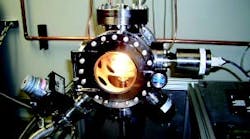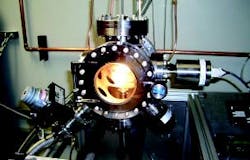The research uncovered a significant difference in friction exhibited by diamond surfaces that had been coated with different isotopes of hydrogen and then rubbed against a small carbon-coated tip. To investigate vibrational resonances, Argonne scientists used single-crystal diamond surfaces coated with layers of atomic hydrogen or deuterium, a hydrogen atom with an extra neuron. The deuterium-terminated diamonds had lower friction forces due to their lower vibrational frequencies, an observation attributed to the isotope's larger mass. Previous attempts to make hydrogen-terminated diamond surfaces relied on the use of plasmas, but these can etch the material, thereby jeopardizing friction research data.
After trying various methods to avoid etching, such as soaking films in olive oil before applying hydrogen layers, lead scientist Anirudha Sumant developed a system for depositing diamond thin films. Known as “hot filament chemical vapor deposition,” the technique involves heating a tungsten filament to over 2,000° C. If the diamond film is exposed to the flow of molecular hydrogen while sitting within 1 cm of the hot filament, the heat causes the molecular hydrogen to break down into atomic hydrogen, which reacts with the film's surface to create a perfectly smooth layer.
Sumant says he hopes to use this discovery to manipulate surface friction on the atomic level, which would be valuable in the development of nanoelectromechanical systems based on diamonds. For more information, visit www.anl.gov.
Help your designs better cope with friction and wear. Consider these expert tips, tools, and atomic-level insights that deal with static and dynamic friction.
Product roundup: Components that reduce friction
Friction-reducing surface treatment
Surface engineering treatment (SET) technology reduces friction between moving parts using a polymer-based machining process. The method creates an oil-retaining organic nanolayer that chemically bonds to metal surfaces, increasing surface hardness and improving surface topography. It has been used to reduce friction in engines, machines, turbines, and bearings, and has even replaced entire bushings.
FriCSo Inc. • www.fricso.com
Friction-compensating motion controllers
SpiiPlus CM multi-axis motion controllers employ advanced algorithms such as disturbance rejection, velocity ripple and dynamic error compensation, and dynamic straightness control to help achieve smooth motion in motor-driven systems. The advanced controllers compensate for both static and dynamic friction, as well as the more complex Stribeck friction observed at low velocities.
ACS Motion Control Inc. • www.acsmotioncontrol.com
Wear-resistant pin clamps
The standard pin clamp has been redesigned with a vanadium carbide coating for extra hardness and wear resistance, as well as durability. Pin diameters range from 5.5 to 59.8 mm. The clamp's “power lock” cylinder has also been redesigned to provide more power and greater holding force. The cylinder is air driven to open and spring actuated to close, which provides greater locking force.
Humphrey Products Co. • www.humphrey-products.com
Low friction pneumatic actuators
The MQ series of metal seal cylinders uses a precision-machined cylinder assembly to minimize sliding friction. With this design, breakaway pressure is available as low as 0.15 psi, making the series well suited to applications such as force and tension control where low breakaway pressure is critical. Bore sizes of 10, 16, 20, 25, 30, and 40 mm are available.
SMC Corp. • www.smcusa.com
Zero-wear magnetic encoders
Noncontact, RLS magnetic rotary encoders consist merely of a magnet and a computer chip. These tiny components impose very little inertia on host systems and, once attached, operate without friction and wear. RLS solid-state encoders are available over a range of precisions (from 7 to 13 bits) and in several output formats, including absolute, incremental, and linear (analog).
Renishaw Inc. • www.renishaw.com
High-friction tires
These tire products, which now feature a shore hardness as low as 5, are used for paper transport in devices such as photocopiers, ATMs, bill validators, and mail handling equipment. Three different manufacturing processes are used to produce the tires, depending on the volume required. For high-volume needs, a process using injection molding of liquid silicone rubber is used. This allows the use of softer materials than before, resulting in an increased coefficient of friction and less paper slippage. Bore sizes range from 6 to 200 mm and all materials are RoHS approved. Tires range from 5 to 80 degree shore hardness A.
Fenner Precision • www.fennerprecision.com

